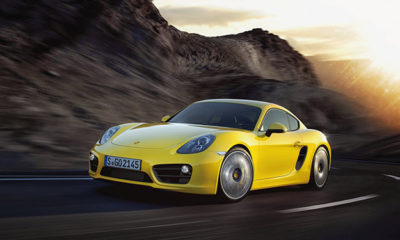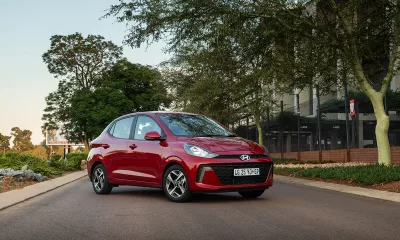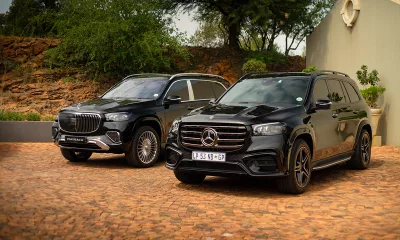Cayman take two. Porsche’s much-lauded mid-engined coupe has been completely revised, boasting more powerful, cleaner engines, a larger cabin and improved performance. Now, more than ever, it intrudes on the 911’s turf. We drove the Cayman in Portugal to find out whether it has, in fact, become the better buy.
The new Cayman looks stunning, borrowing design cues from the Boxster and translating them into a taut, aggressive shape. Slightly larger than the first generation, with 60 mm more added to the wheelbase, the new Cayman sports big side airdams with an aggressive central airdam as opposed to the smaller, less aggressive version on the Boxster. These side units are used to cool radiators for air-conditioning and engine coolant. The rear sports neat, narrow tail-lamps that morph into the spoiler lines. A full-length LED brakelamp covers the entire top span of the rear windscreen. The curves and creases work brilliantly together to create a package that is visually close to perfection.
While stiffening the body, the engineers have managed to reduce the overall mass by 30 kg to around 1 350 kg on the base model, thus adding a small but significant improvement to both acceleration and fuel consumption. The body is now 44 per cent aluminium to help save mass. Other technical features include stop/start and a coasting function which selects neutral in the PDK transmission under suitable driving conditions. Standard wheels are 18 and 19 inchers in the two models, but 20 inchers (as fitted to some of the test units) are optional. Steering is now electric assisted instead of hydraulic, while buyers have the option of a six-speed manual gearbox and seven-speed PDK.
The Cayman now offers extra oomph from its flat-six engine to boost power/torque from 195 kW/300 N.m for the previous 2,9 litre to 202 kW/290 N.m for the new 2,7-litre, while the 3,4-litre S goes further, from 235 kW/370 N.m to 239kW/370 N.m. Fuel consumption is all important and the new models are claimed to be up to 15 per cent more frugal (8,2 and 8,8 L/100 km for the two versions).
On the twisty and sometimes bumpy roads around Faro in southern Portugal, what stood out apart from the decent power delivery of the S was the absolutely brilliant suspension. Whether in normal or sport plus mode, the compliance remained while ensuring excellent handling characteristics. The front track has been increased by 36 mm on the standard model and 40 mm on the S to further improve cornering ability.
Later in the day, on Portimao Racetrack, an undulating and very technical circuit, I was fortunate to be able to hop into one of the very few manual base cars. Thinking that I would be disappointed, I was proven wrong. It felt and sounded great, and could keep up with most of the higher powered PDK-bestowed S cars by making full use of the full range up to 7 800 r/min. The only problem was that, after over a week of these cars being thoroughly manhandled by journalists worldwide, the poor, overworked Pirelli P Zeros were shot and the rear-end was becoming very loose. This did give an opportunity to experience the superior poise and balance of the mid-engined layout (mass distribution 46/54 front/rear) and it was not too difficult to catch the slides with snatches of opposite lock. Talking about the steering, this electrical system (I hate electrical steering) has to be the best of the bunch, with very little to complain about. Well done, Porsche engineers!
After the 2,7, I tried the 3,4-litre with PDK and, while I would be happy with the cheaper version, the S certainly has a clear advantage, both in power and with the excellent seven-speed PDK ‘box. This car’s tyres were hurting even more so the steering was given more work than normal. Another observation is that, apart from the tyres, none of the cars showed the slightest hint, mechanically speaking, of any wear and tear. Gear shifting is quick using the paddles and, with this PDK ‘box, one gets the feeling of unburstability, not the “how long is this fancy tranny going to last” feeling that one gets with some other examples of double-clutch gearboxes.
Acceleration? 0 to 100 km/h in 4,7 seconds for the S and 5,4 for the standard version (both with sport plus and PDK). Top speed? 264 km/h and 281 km/h respectively.
Many options, as always, are available, from a top-end Burmester audio system, to adaptive cruise control and various cabin colours. Sports seats are standard but there is a sport-seat plus system available with even more lateral support.
Value for money is not something you easily sprout out when talking of R600 000 to R900 000 but, considering the savings on a 911 or a number of other mouth-watering options, there’s real value here. Whether I would choose it over a 911 would depend entirely on my budget. However, the simple fact is the Cayman is so brilliant that I’d be very, very happy with it.
Pricing in South Africa will be R638 000 for the Cayman and R788 000 for the Cayman S (before choosing your options) and the order is book is already open for first deliveries in April.










